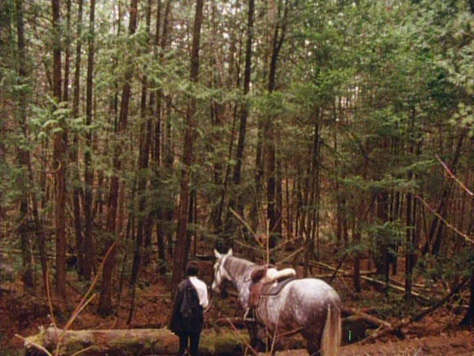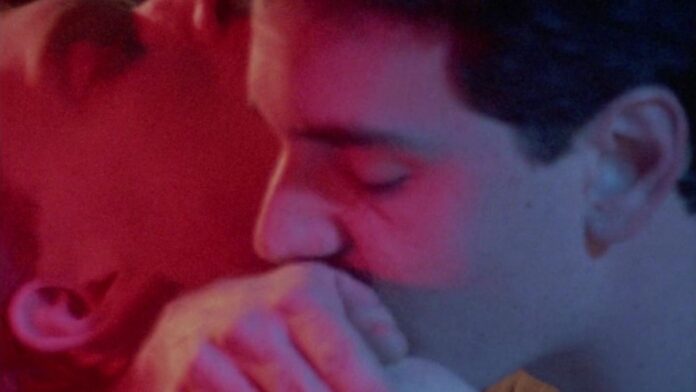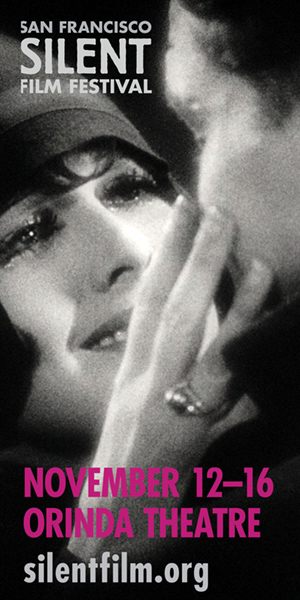Romcoms are not my favorite genre. Still, it’s surprising there’s such a paucity of them opening this Valentine’s Day, which happens to be a Friday—the perfect marketing opportunity, you’d think. Nonetheless, for those who’d rather not say it with flowers, there are some relevant big- and small-screen datenight options over the next few days. One (though it doesn’t start until Sun/16) is “40 Years of Queer,” a six-week roundup of LGBTQ+ titles at the Roxie, co-curated by that venue’s Lex Sloan and longtime Bay Area-based filmmaker, archivist and writer Jenni Olson.
The first titles on the schedule are from the late Arthur Bressan, Jr., who made the first US narrative feature addressing the AIDS epidemic in 1985 (Buddies, playing Feb. 22) and became one of its casualties just two years later, at age 44. Olson is much involved in The Bressan Project, which is restoring and re-releasing his work. Alongside documentaries and serious dramas, he wrote, directed and edited a half dozen pornos—mostly for the money, it seems, but expending much more conceptual and stylistic imagination on them than was typical for the genre.
The series starts this Sunday with his 1984 Daddy Dearest, a very meta exercise in which a fictive NYC porn director (Daniel Holt) imagines scenes from his next opus even as he’s casting it and planning other logistics. Not part of the Roxie program, but also part of the “Project,” will be a Mon/24 screening at the 4-Star of Juice, which came out later the same year and proved Bressan’s last adult feature. It’s another surprisingly sophisticated weaving of reality and fantasy, this time hinging on a photographer (Michael Christopher) scrambling to find fresh models by deadline to suit a finicky gay skin-mag editor. Both these shows will feature Olson in conversation with yours truly—though I’ll admit to never having seen either film before last week.
March 1 brings Oakland-based Cheryl Dunye’s 1996 first feature The Watermelon Woman, a milestone amid the decade’s New Queer Cinema movement that imagined a modern-day Black lesbian filmmaker (played by the director) researching a fictitious actress who’d played fleeting, stereotypical maid or mammy roles in Hollywood’s “golden age.” Its critical examination of screen representation has room for real-world offscreen intellects such as Sarah Schulman, Alex Juhasz and Camille Paglia. On March 15, Susan Stryker and Victor Silverman’s 2005 documentary Screaming Queens: The Riot at Compton’s Cafeteria recalls an incident of gay/trans resistance similar to the famous 1969 one at Stonewall Inn—which greatly overshadowed it, though the incident in SF’s Tenderloin happened a full three years earlier.
Finally in early April there are revivals of Olson’s own nonfiction features, uniquely poetical essayistic mixtures of history, landscape, and personal rumination. 2005’s The Joy of Life (showing Tues. April 8) muses on—among many other things—the Golden Gate Bridge as a suicide magnet. Those who heeded that call included Mark Finch, her late colleague at Frameline, who bears the film’s dedication. Released a decade later, The Royal Road (Tues. 4/1) applies a similar avant-garde yet accessible sensibility to a sweeping consideration of California’s Spanish-colonialist legacy—as well as the state as a state of desire, for the “American dream” as well as love, romance and sex. Both features will be accompanied by Olson shorts, and a Q&A with the filmmaker herself. For info on the whole series, go here.

Also combining the experimental with the autobiographical are the two mid-length works on a bill entitled “Your Life Is Like A Candle Burning,” presented by SF Cinematheque at The Lab this Thurs/13. Barbara Sternberg’s Like A Dream That Vanishes (1999) and In the Nature of Things (2011) are rich, densely layered 16mm assemblies of scenes from family life, the outdoors, historical artifacts, and much more. They carry a weight of philosophical inquiry into everyday experience that turns these approximately 40-minute films into complex windows on a personal world, or rather a personal perspective on a larger one. The Toronto-based maker was a pioneering female amongst Canada’s underground cinema scene as far back as the early 1970s, and remains active in her own later seventies. This program (more info here) provides a rare local opportunity to see a major talent of the last half-century on the big screen.
Other notable film arrivals this week:
When “Forever” Love Is Wrong: ‘The Dead Thing,’ ‘Timestalker’
Help us save local journalism!
Every tax-deductible donation helps us grow to cover the issues that mean the most to our community. Become a 48 Hills Hero and support the only daily progressive news source in the Bay Area.
It’s romantic to think of love as something that might transcend all limits of space, time and mortality. But best not to think too closely on how that might work in the real world.
In writer-director Elric Kane’s debut feature The Dead Thing, which begins streaming on genre platform Shudder this Fri/14, Alex (Blu Hunt) is a rudderless L.A. twentysomething who seeks distraction from her boring dayjob via hookups aren’t fulfilling, either. That is, until she meets Kyle (Ben Smith-Petersen), with whom she experiences mutual chemistry. But then he pulls a disappearing act—and she sees him out with other women. Irate, she goes to the cafe where he’d worked, only to be informed that Kyle died in an accident some weeks before. Yet somehow he’s still “alive” to her, even great in bed, despite his lack of memory, not to mention…uh, life signs, like a pulse.
Billed as an “erotic thriller,” Thing does have a lot of sex scenes, but it’s short on thrills (even when undead Kyle turns homicidal). Ditto plot, character involvement, and internal logic. We can suspend disbelief over the fact that Kyle’s status is so poorly defined, in that he has material form in some respects and not others. But he and Alex are such blank slates, we can’t careabout them, let alone buy into their supposed grand passion—they seem too apathetic and petulant for such emotions. While the film does have a certain spectral atmosphere to it (largely thanks to an interesting musical score), it ultimately seems a pretentious tease minus sufficient style or ideas to get away with so little narrative propulsion.
By contrast, there’s no lack of humor in Timestalker, the 2nd feature from writer/director/star Alice Lowe, a familiar face in British comedy since the cult series Garth Marenghi’s Darkplace. She plays Agnes, who first sets eyes on Alex (Aneurin Barnard) when he’s about to be executed for supposed witchcraft in the 17th century. It’s love at first sight—as well as very poor judgement, something that gets repeated over and over as both of them (plus additional figures played by Nick Frost, Jacob Anderson, Tanya Reynolds and others) get repeatedly reincarnated, all the way to A.D. 2117.
It’s a great concept that’s droll and colorful enough in execution. Though as with Lowe’s prior Prevenge, the result is an antic black comedy that never quite catches fire. The wigs she wears are funnier than the underdeveloped situations or characters, and the cultural satire continually raises expectations without scoring any major points. The idea of someone chasing a Mr. Wrong through the ages—let alone discovering in the end that, in fact, she is the problem—is so good, one hopes a movie comes along some day that exploits it more fully than this mildly amusing exercise. Timestalker releases to theaters and On Demand platforms Fri/14; at presstime, no Bay Area venues were yet confirmed.
Paddington in Peru
There’s nothing so macabre—a stray spider, snake or ghost aside—about the latest installment in this franchise drawn from Michael Bond’s long-running series of endearingly very English children’s books. Here, the forever well-intentioned but bumbling Paddington Bear (voiced again by Ben Whishaw) is informed that his beloved Aunt Lucy (Imelda Staunton) is ill. So he and his adoptive human Brown family (led by Emily Mortimer and Hugh Bonneville) decamp from London to Peru, where she’s living in a “Home for Retired Bears” run by nuns. Upon arrival, however, they find that Lucy has gone missing, and there is something fishy about the resident Reverend Mother (Olivia Colman). Hiring a local tour guide (Antonio Banderas) and his boat, they go up the Amazon in search of the lost lady—while other parties are duplicitously in search of ancient, rumored Inca gold.
This is the first big-screen Paddington outing not to be written and directed by Paul King; instead it’s the feature directorial debut for Dougal Wilson, a veteran of music videos and commercials. He does a perfectly good job, lending a confectionary look to this elaborate fantasy, with its first-rate CGI effects, impressive scenery and production design. But he’s also got a very hard act to follow, in that Paddington 2 was not just the rare sequel that’s better than its predecessor, it’s one of the best movies of the last decade—and I say that as someone who generally avoids “family entertainments” like the plague. Inspiration here is just middling by comparison, eventually arriving at a decent but familiar mix of slapstick and sentimentality. Even Banderas, having fun playing his character’s various apparitional ancestors, doesn’t hit the highs of 2’s disguise-master Hugh Grant. Nevertheless, Peru remains lively, charming, and above average as all-ages adventures go. It opens in theaters nationwide Fri/14.
No Other Land
Last but far from least, there’s a new film that is probably not what anyone would want to see for Valentine’s Day, but is also the most important new release that everyone ought to see. That would be the Oscar-nominated documentary by Basel Adra, Hamdan Ballal, Yuval Abraham, and Rachel Szor, an activist collective who recorded the methodical displacement of Palestinian communities in Adra’s southern West Bank homeland over four years’ course. They also had access to a prior two decades of those communities’ own videotapes, chronicling the gradual erasure of villages the Israeli government now claims never existed. (Even if they are on maps from past centuries.)
Homes, schools, playgrounds, generators, and even chicken coops get bulldozed on-camera. Property like cars is seized, wells are filled with cement. These things happen under orders for which no one will claim responsibility, yet the Israeli courts now rubber-stamp. Residents are arbitrarily arrested, beaten, shot; violence from Jewish settlers escalates, unpunished by authorities. The justifying logic is that somehow these Palestinians are illegally occupying land owned by their families over generations. No explanatory logic at all is given when people are “evicted” and their houses razed to allow Israeli Army “tank training”…despite there being open, uninhabited land available for that purpose nearby.
Much of this is brutal, and maddening. At one point Adra’s family is forced to go live in a cave. Still worse lies ahead, as an epilogue informs us. No Other Land stopped filming just before the Hamas attacks of October 2023, so you could argue it doesn’t show the “whole picture.” And its impact is diluted a bit by a running focus on Adra’s friendship with sympathetic Israeli investigative journalist Abraham. Their alliance was no doubt necessary for the amount of access achieved here, but at times seems a little beside the main point. That point, however, is the relentless persecution of a permanent population that is inconvenient to its occupiers. It’s hard to imagine anyone watching this film and remaining blind to a monumental injustice whose likely conclusion looks bleaker than ever in our current political climate. No Other Land opens Fri/15 at the Roxie in SF.





